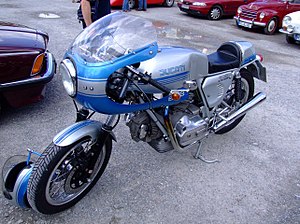Ducati 900SS bevel shaft
| Ducati | |
|---|---|

|
|
| Ducati 900SS | |
| Manufacturer | Ducati |
| Production period | 1975 to 1982 |
| class | motorcycle |
| Motor data | |
| V-90 ° two-cylinder engine | |
| Displacement (cm³) | 863.9 |
| Power (kW / PS ) | 50 kW (68 hp) |
| Top speed ( km / h) | over 225 |
| transmission | 5 courses |
| drive | Chain drive |
| Brakes | Front: double disc brake 280 mm.Rear: brake disc 229 mm |
| Wheelbase (mm) | 1500 |
| Dimensions (L × W × H, mm): | 2210 × 675 ×? |
| Seat height (cm) | 770 |
| Empty weight (kg) | 194 |
| Previous model | 750SS |
| successor | 900 S2 |
The 900SS with vertical shaft was a model of the Italian motorcycle manufacturer Ducati , which was built from 1975 to 1982. The "SS" in the model name stands for "Super Sport".
technology
The basis for this motorcycle are the Ducati models 860GT / GTS and 750SS . The new (angular) crankcase and displacement (863.9 cm³) have been adopted from the 860GT / GTS . The design comes from the 750SS with the typical half- casing and the round seat hump and the Desmo cylinder heads.
In particular, the frame, which was adopted from the 750GT and 750SS, and the stiff struts were far superior to the Japanese products of the time. The weight was only 194 kg. The Ducati has a long wheelbase (approx. 1.5 m) for a sporty machine . As a result, it had a very stable driving behavior at high speeds for the time. However, compared to modern sports machines, the suitability for everyday use is u. a. limited due to the kick starter and the sluggish turning behavior.
engine
The air-cooled V2 engine with a cylinder angle of 90 ° runs quietly, but is very noisy as many gears are installed, nine bevel gears for the vertical shafts alone . The cylinders have large cooling fins, the mixture forming two 40 mm Dell'Orto - carburetor without air filter (coarse screens before inlet funnel), the Conti-exhaust pipes are hardly attenuated. The output is 73 hp on the crankshaft at 7000 rpm. Thanks to the desmodromic valve control , the engine can turn up to 8500 rpm. The design of the desmo heads goes back in part to the 100 Gran Sport (Marianna). Although this model did not yet have a desmodromic system, it also had two valves with an 80 ° angle. Hairpin valve springs were also used on the 900SS cylinder heads. The transmission has five gears and was initially shifted using the right foot pedal. For the 1977 model year, the usual left-hand shift was used. The split crankshaft is mounted in four ball bearings, the connecting rods are equipped with needle bearings.
Model history
Initially, Ducati wanted to produce the 900SS in a limited edition like the 750SS. This is why the first 900SSs were built in the racing department and equipped with the same GRP tank as the 750SS. When switching to series production , a steel tank was finally used.
The motorcycle was used with great success in series machine races by private riders . In the 1980s, the 900SS were still very successful in Battle of Twins races, the racing class for two-cylinder motorcycles.
Due to the poor silencing, Ducati had more and more problems selling the 900SS abroad. For this reason, for sales in some countries, the Conti silencers were replaced by relatively heavily damped, thus performance-reducing and heavy Silentium silencers. In addition, machines equipped in this way received Dell'Orto carburettors with a passage of only 32 millimeters and an air filter system. A test by the "Motorrad" magazine showed how much this conversion drained performance. There, on a test machine, only the exhausts and the carburettors were exchanged for the non-noise-suppressed versions without any further adjustment work, which increased the top speed by around 20 km / h.
In 1982 the last 900SS left the Ducati plant in Borgo Panigale . The 900SS was replaced by the less characterful 900 S2 , which borrowed less from racing machines in terms of design and had an electric starter. Most of the parts have been taken over from the 900SS, the engine has been thoroughly revised. The heavy half-shell of the Pantah replaced the lighter previous model. The 900 S2 was only delivered with the Silentium silencers and heavy air filter boxes. A larger battery was installed for the electric starter . In order to create space for the new battery, frame tubes with a smaller diameter were used in some cases. In the frame triangle, only a halved tube was used on each side. All of these changes led to a reduction in chassis stability.
literature
- Alan Cathcart: Ducati motorcycles . Motorbuch Verlag, Stuttgart 1995, ISBN 3-613-01051-8
- Roland Brown: Motorcycles. Fascination and adventure. Parragon Books, ISBN 1-40544-603-X
- Mick Walker: Ducati . Heel, Königswinter 1994, ISBN 3-89365-403-8
